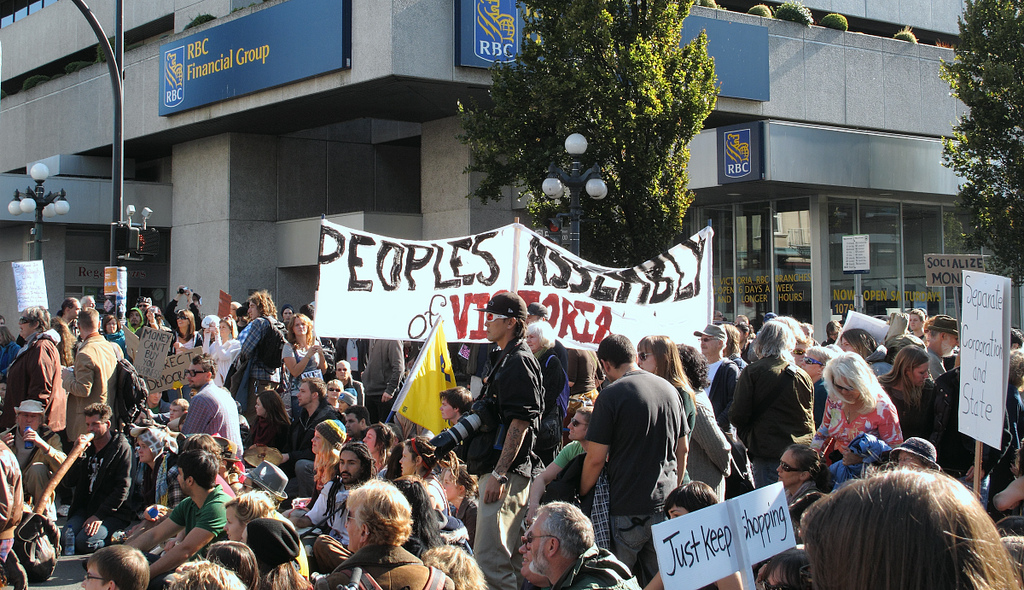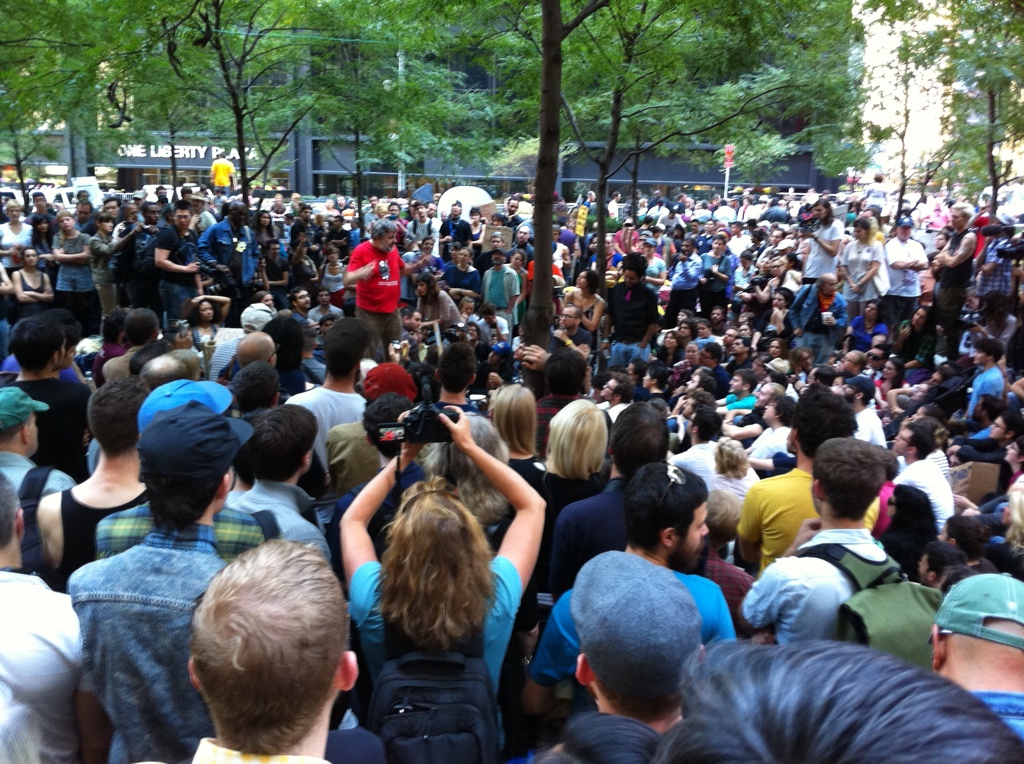Chapter 6: Groups and Organizations

Introduction to Groups and Organizations
The punk band NOFX is playing outside in Los Angeles. The music is loud, the crowd pumped up and excited. But neither the lyrics nor the people in the audience are quite what you might expect. Mixed in with the punks and young rebel students are members of local unions, from well-dressed teachers to more grizzled labour leaders. The lyrics are not published anywhere but are available on YouTube: “We’re here to represent/The 99 percent/Occupy, occupy, occupy.” The song: “Wouldn’t It Be Nice If Every Movement Had a Theme Song” (Cabrel, 2011).
The slogan, “We are the 99%,” emblematic of the Occupy movement that flourished in North America in 2011 and 2012, refers to the transfer of wealth from the middle class to the upper class (the “one percenters”). Even during the severe economic crisis after 2008, the personal income, bonuses, and overall share of social wealth of the elite 1% increased. Occupiers observed that the very people responsible for the crisis and the massive loss of wealth in the economy were paying themselves bonuses for a job well done, even while they were receiving billions of dollars in bailouts from the government. This would seem to be a grievance worthy of a movement, but simply having a grievance does not explain the ways in which movements take form as groups.
In Victoria, B.C., a tent community sprang up in Centennial Square outside city hall, just like tent cities in other parts of the country. Through the “horizontal decision-making process” of daily general assemblies, the community decided to change its name from Occupy Victoria to the People’s Assembly of Victoria because of the negative colonial connotations of the word “occupy” for Aboriginal members of the group. Occupy Montreal adopted the concept of stepping back or “progressive stack” in their meetings. Men and other dominant movement figures were encouraged to step back from monopolizing the conversation so that a diversity of opinions and experiences could be heard. As the tent cities of the Occupy movement began to be dismantled, forcibly in some cases, a separate movement, Idle No More, emerged to advocate for Aboriginal justice and organized itself according to Aboriginal principles of decentralized leadership. Horizontal decision-making processes, progressive stack, and decentralized leadership refer to the different organizational structures these social movements experimented with in rethinking traditional hierarchical structures of organization.

Numerous groups made up the Occupy movement, yet there was no central movement leader. What makes a group something more than just a collection of people? How are leadership functions and styles established in a group dynamic? What unites the people protesting from New York City to Victoria, B.C.? Are homeless people truly aligned with law school students? Do Aboriginal people genuinely feel for the environmental protests against pipelines and fish farming? How does a non-hierarchical organization work? How is the social order of a diverse group maintained when there are no formal regulations in place? What are the implicit or tacit rules that such groups rely on? How do members come to share a common set of meanings concerning what the movement is about?
At one point during the occupation of Wall Street in New York, speakers like Slovenian social critic and philosopher Slavoj Žižek were obliged to abandon the use of microphones and amplification to comply with noise bylaws. They gave their speeches one line at a time and the people within earshot repeated the lines so that those further away could hear. How did this communicational format, despite its cumbersome nature, come to be an expression of the group’s solidarity?
Most of us feel comfortable using the word “group” without giving it much thought. But what does it mean to be part of a group? The concept of a group is central to much of how we think about society and human interaction. As Georg Simmel (1858–1915) put it, “society exists where a number of individuals enter into interaction” (1908/1950). Society exists in and through groups. For Simmel, society did not exist otherwise. What fascinated him was the way in which people mutually attune to one another to create relatively enduring forms. In a group, individuals behave differently than they would if they were alone. They conform, they resist, they forge alliances, they cooperate, they betray, they organize, they defer gratification, they show respect, they expect obedience, they share, they manipulate, they riot, etc. At this meso-level of interaction, being in a group changes their behaviour and also their abilities. Emile Durkheim recognized that groups generate their own particular energy — collective effervescence — that gives group members confidence and powers of action they otherwise would not have. This is one of the founding insights of sociology: the whole is greater than the sum of its parts. The group has properties over and above the properties of its individual members. It has a reality sui generis, of its own kind. But how exactly does the whole come to be greater?
Additional Optional Resources
The Magic of collective effervescence by Victoria Matey
This podcast episode explores the concept of “collective effervescence,” a term coined by sociologist Émile Durkheim to describe the sense of unity experienced by groups during shared rituals or events. The podcast discusses how this phenomenon can enhance group cohesion, foster a sense of belonging, and boost collective support. It also highlights practical applications of collective effervescence, suggesting that harnessing this energy can create more engaging and impactful experiences for group members.
Balanced and Healthy Group Identities by Xavier Bonilla
In this podcast, the speaker examines the importance of maintaining balanced and healthy identities within groups. It discusses how group identities can influence dynamics, performance, and well-being. Additionally, it explores strategies for fostering positive group identities, including promoting inclusivity, addressing conflicts, and ensuring that individual identities are valued.
Social Structure & Organizations by Rohin, Tom, Pedro, Shelby
This podcast delves into the work of Arthur Stinchcombe on social structure and organizations. It explores how organizational structures are influenced by societal norms and historical contexts. Stinchcombe’s theories suggest that the social environment shapes organizational forms and practices, emphasizing that organizations are not isolated entities but are deeply interconnected with broader social systems. The podcast addresses how these insights from Stinchcombe’s work can be applied to understanding contemporary organizational dynamics.
Section Summary
6.1 Defining a Group
Groups largely define how we think of ourselves. There are two main types of groups: primary and secondary. As the names suggest, the primary group is the long-term, complex one. People use groups as standards of comparison to define themselves—both who they are and who they are not. Sometimes groups can be used to exclude people or as a tool that strengthens prejudice.
6.2 Group Size and Structure
The size and dynamic of a group greatly affects how members act. Primary groups rarely have formal leaders, although there can be informal leadership. Groups generally are considered large when there are too many members for a simultaneous discussion. In secondary groups there are two types of leadership functions, with expressive leaders focused on emotional health and wellness, and instrumental leaders more focused on results. Further, there are different leadership styles: democratic leaders, authoritarian leaders, and laissez-faire leaders.
Within a group, conformity is the extent to which people want to go along with the norm. A number of experiments have illustrated how strong the drive to conform can be. It is worth considering real-life examples of how conformity and obedience can lead people to ethically and morally suspect acts.
6.3 Formal Organizations
Large organizations fall into three main categories: normative/voluntary, coercive, and utilitarian. We live in a time of contradiction: while the pace of change and technology are requiring people to be more nimble and less bureaucratic in their thinking, large bureaucracies like hospitals, schools, and governments are more hampered than ever by their organizational format. At the same time, the past few decades have seen the development of a trend to bureaucratize and conventionalize local institutions. Increasingly, Main Streets across the country resemble each other; instead of a Bob’s Coffee Shop and Jane’s Hair Salon there is a Dunkin Donuts and a Supercuts. This trend has been referred to as the McDonaldization of society.
Media Attributions
- Occupy Victoria © r.a. peterson is licensed under a CC BY-SA (Attribution ShareAlike) license
- “You don’t need to be a genius to lead, anyone can be leader” -Zizek @OccupyWallStNYC © Daniel Latorre is licensed under a CC BY (Attribution) license

